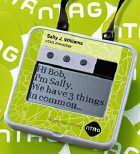April 10, 2003 – At a conference to be held in Las Vegas later this month, attendees won’t have trouble identifying the people they want to meet. That’s because everyone will be wearing an nTag, an RFID-powered conference badge that could make events more productive for both attendees and organizers.
The nTag, which are about four inches wide, three inches tall, slightly less than 1 inch deep, is the brainchild of a New York startup with the same name. The small, lightweight computer hangs around an attendee’s neck during a conference. Each nTag has a semi-passive RFID tag operating in the UHF band, which enables a conference organizer to use it for security, to record how many people attended certain sessions, or to track how many people visited certain areas of an exposition floor.
Readers placed strategically around the meeting rooms and show floor can scan data off the tag or write to the tags. So the nTag can be used for interactive audience response and polling. Organizers can also send messages to all attendees or to specific attendees without having to page them. The tags can be reprogrammed en masse.
Today, many exhibitors at tradeshows ask visitors to put a business card in a fishbowl, or employees scan a bar code on their badge. With nTag, a reader can register foot traffic. The tags also use infrared to communicate with one another. So exhibitors can see which booth staff engaged the most people. And attendees can press a button on their device to indicate whether they want follow up. “That information is priceless,” says nTag’s George Eberstadt.
Organizers can ask attendees to include personal information when they register, such as favorite sport or hobby, as well as what he/she would like to accomplish at the show, and other relevant information. Simple multiple-choice questions can be answered directly on the nTag using scroll buttons. If the information is required is more detailed, registrants can enter it into a form on the Web and then it is downloaded to their nTag. The company usually has kiosks around the event floor, so that attendees can update the data on their tags.
When two people meet, the tags transmit information to one another and display simple messages, such as: “Hi, Bill. I’m Tom. I see you are an integrator. I’m looking to meet integrators.” The aim is to help attendees get over the problem of not knowing whom to meet or how to respond to people they do meet.
“When you meet someone at one of these events, you want to determine pretty quickly whether it is likely to lead to a productive interaction,” says Eberstadt. “If so, let’s not waste time discussing the weather. Let’s talk of what’s of interest to us both.”
The tags operate as normal event badges, displaying your own name. But when you tilt your nTag up to look at it, a tilt sensor inside triggers the screen to turn upside down, so it is right-side up for you. The device automatically displays a menu, which you can scroll through with one hand (in case you have a drink in the other).
You can scroll through to find the conference agenda, or you can press a button and transmit your business card information to the person you are talking to. The information is recorded on their nTag device. The tags have to be returned at the end of the event. nTag downloads the data and sends you an e-mail with the contact information of all the people who wanted you to have it. The e-mail also includes information about what you had in common with each person.
There’s no limit to how many users can be on the ystem. nTag offers discounts for events with more people, but charges more for longer events than shorter ones because it must set up and maintain the reader infrastructure and provide on-site services. “We like to say that for the cost of a meal, which will soon be forgotten, they can give attendees something that they will remember and which will completely transform the experience for them,” Eberstadt says.
nTag has the most complete solution, but it’s not the only company pursuing this market. A Santa Monica, Calif. outfit called Charmed Technology offers an infrared badge that for interpersonal communications. But it does not use RFID, so it lacks the tracking functions of nTag.
In Europe, a Swiss company called Shockfish has developed a handheld computer that stores photos and helps you locate people you never met before. But it doesn’t facilitate interaction. And the National Center for Supercomputing Applications has developed the IntelliBadge for tracking. It was used at Supercomputing 2002, but is not ready for commercialization yet.


